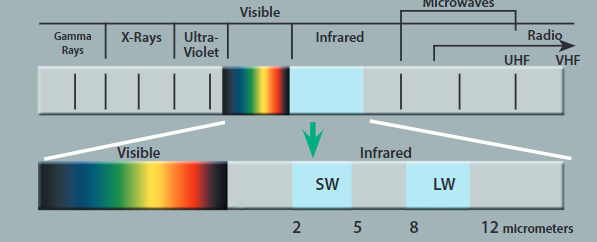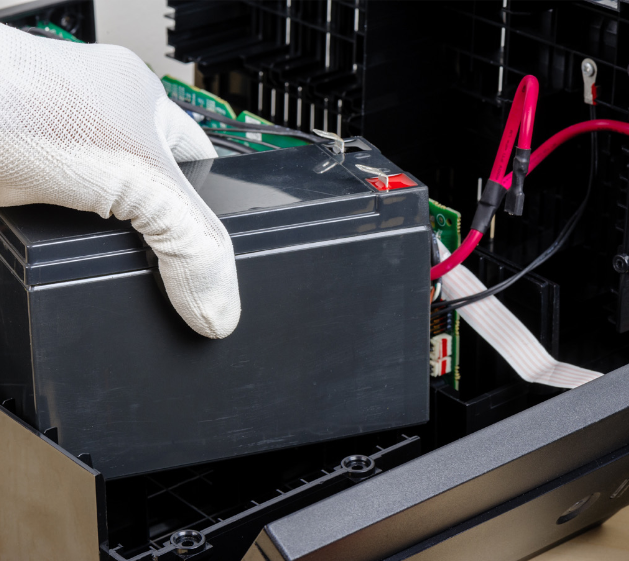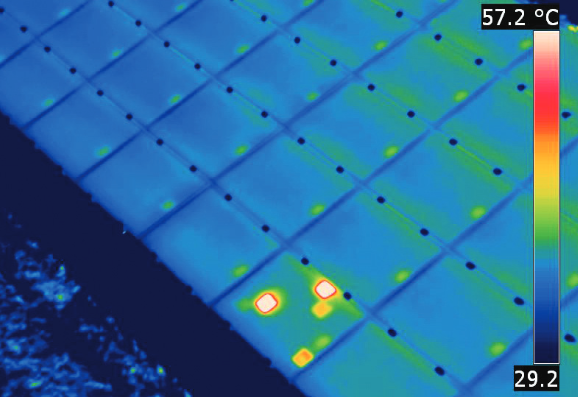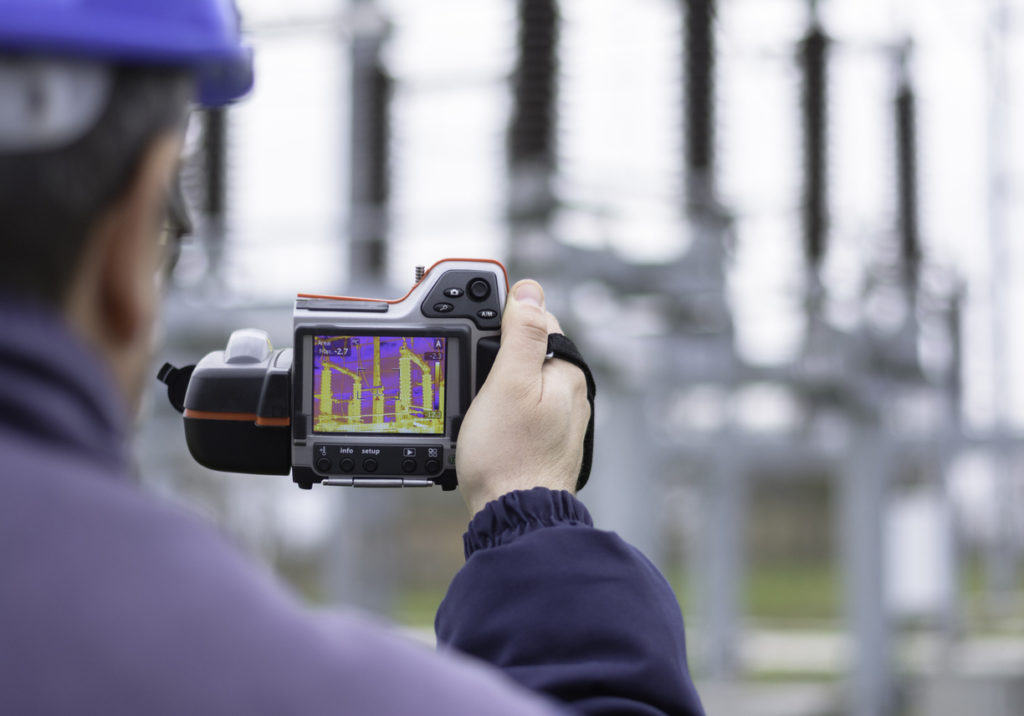What is a thermal imager?
A thermal imager is a device which is used to detect small variances in temperature in a range of industries and settings, such as healthcare, transport and electrical maintenance. Thermal energy and infrared radiation are used to gather data on equipment and create images of them, even in low visibility situations, such as fog, haze and smoke. The device can spot a variety of electrical problems before they occur, preventing machine failure or electrical hazards.
A lot of equipment problems in industrial environments can be identified by vibrations or sounds, but these signs don’t cover all potential issues presented by industrial equipment. A thermal imager uses a piece of kit’s thermal patterns to determine whether it is functioning normally or whether it might endure a problem.
How does a thermal imager work?
Each piece of equipment which has a temperature of above absolute zero (-273.15 degrees celsius) emits infrared radiation. This energy that emanates from an object is called its heat signature, with a hotter temperature giving out a higher rate of radiation. The thermal imager (or camera) translates this data into an electronic image which is visible on the device interface, so the user can immediately see the temperature of a piece of equipment visually. As machines and devices are very rarely the same temperature as other pieces of equipment in their vicinity, it’s easy for the thermal camera to detect them and distinguish them from each other in its image.

Why do data centres need thermal imagers?
The demand for data centres has skyrocketed over the last few years, with further growth expected in the next decade. Data centre facilities are being built in all four corners of the globe at a fast pace as a result of increased popularity of cloud technologies such as AI, IoT and 5G. According to a report by Research and Markets, revenues from data centres could rise by up to 60% in the next four years.
The downtime of a data centre needs to be avoided at all costs as it has a substantial negative economic impact. But that’s not all, data centre downtime can also lead to reputational damage for a business, especially if they offer customer-facing services. As there is so much mechanical, electrical and electronic infrastructure under one roof, guaranteeing uptime has become increasingly complex for data centres. Overheating of equipment is a big concern as it can cause complete shutdown of the servers, which can affect users from all over the world. Thermal imaging cameras allow the operator to monitor the temperature of these machines to ensure that the worst doesn’t happen ahead of time.
Benefits of using a thermal imager
See the whole picture
Thermal imaging cameras allow you to scan wider areas for hot spots or temperature changes, unlike infrared thermometers or thermocouples. Without a thermal camera, it’s simple to overlook important factors like air leakages, areas with insufficient insulation or water intrusion. The device can scan entire buildings, HVAC (heating, ventilation and air conditioning) systems, and electronic installations. It allows you to compare the temperatures of components within the same setting much simpler, and it never misses a potential problem area.
Save time and costs
The maintenance of data centre installations can be labour-intensive. However, due to the thermal imager’s capabilities to capture broader surface areas, they can be very effective at lowering maintenance time, speeding up inspection rounds, and detecting impending problems before they turn into costly operations.
Carry out inspections without shutting down equipment
As thermal imaging is a non-contact method, it means that operators can execute procedures safely without having to touch any hot equipment. In addition, it also means that inspections can take place without having to interrupt the usual function of the equipment. This also saves money on scheduled downtime for machines. There are some inspections, like the rotary UPS systems, which must be carried out during operation. For these types of procedures, the thermal camera is the perfect tool.
Take reporting to the next level
With the use of thermal imaging cameras, users may create expert, more comprehensive reports of their inspections that appeal to management and clients alike. Users can find trends by comparing recent inspections with earlier data. The usability of today’s reporting solutions is further improved by features like templates, batch processing, image editing, and route planning.
Maintenance inspections with thermal imaging
In the modern world, maintenance encompasses a lot more than just IT operations. To prevent mechanical or electrical failures and subsequent outages, power distribution centres and cooling infrastructure are also essential. A lot of systems which are vital to keep the data centre up and running heat up before they cut out. Infrared thermography (thermal imaging) is a perfect instrument to evaluate power consumption, electrical installations, cooling equipment, and computing gear because temperature is a significant indicator of energy consumption and equipment operation.

Predictive and preventative maintenance strategies have become completely dependent on routine inspections with a thermal imaging camera. Maintenance personnel can identify issues with electrical switchgear, motors, HVAC infrastructure, uninterruptible power supplies (UPS), power distribution units (PDU), batteries and generator equipment and all electrical devices that supply the server systems, using thermal cameras. Thermal imaging makes it possible for maintenance staff to identify any issues before they result in major failures and significant downtime.
Higher computer density and power efficiency are becoming increasingly necessary as cloud computing becomes the new norm and data centres grow exponentially. Owners of data centres are looking for ways to expand their capacity while also lowering costs and energy use.They can use thermal imaging to get crucial data on how to reduce their energy and space needs while preventing overheating.
Routine thermal imaging checks can assist maintenance personnel to:
- Identify any hidden issues and address them before they result in unscheduled overtime.
- Reduce the possibility that circuit overloads or weak connections will cause component degradation to go undetected.
- Prevent equipment failures.
- Achieve optimal space and energy management.
Where can thermal imaging be most effective?
In order to handle the many maintenance and inspection tasks for data centres, thermal imaging is the ideal technology.
In order to handle the many maintenance and inspection tasks for data centres, thermal imaging is the ideal technology.
Electrical and mechanical systems
A range of electrical or power-generation related systems can be inspected using thermal imaging cameras. When monitoring the condition of an electrical installation, heat is a very good indicator of any defects it might have. Heat is produced when current flows through a resistive element. Electrical connections may become more resistant with time, as a result of corrosion and loosening. The corresponding rise in temperature can cause components to fail, leading to unplanned outages.
Load imbalances and increases in current impedance are some issues that electrical systems may encounter. Thermal imaging can quickly locate hot spots, determine the severity of the problem, and help establish the time frame in which the equipment should be repaired.
Thermal imaging cameras can help to detect issues with:
- Overheated connections
- Overloaded or imbalanced circuits
- Damaged switches
- Faulty fuses
- Power supplies
- Battery systems
- Generator systems
- Uninterruptible Power Supplies (UPS)
- Transformers
- Electrical panels
- Resistive load banks
HVAC and cooling systems
Data centres require ideal air-cooling conditions in order to operate smoothly and effectively. A hot aisle/cold aisle configuration is frequently used in data centres. Server racks are arranged in aisles with the fronts facing each other. The cold aisles receive cold air from the Computer Room Air-Conditioning (CRAC) unit, which is located at the bottom of the raised floor. This cool air chills the servers on the racks. At the same time, the rears of the servers pump out hot air to the hot aisle, which is then directed back to the CRAC unit.
A range of electrical or power-generation related systems can be inspected using thermal imaging cameras. When monitoring the condition of an electrical installation, heat is a very good indicator of any defects it might have. Heat is produced when current flows through a resistive element. Electrical connections may become more resistant with time, as a result of corrosion and loosening. The corresponding rise in temperature can cause components to fail, leading to unplanned outages.
Load imbalances and increases in current impedance are some issues that electrical systems may encounter. Thermal imaging can quickly locate hot spots, determine the severity of the problem, and help establish the time frame in which the equipment should be repaired.
Thermal imaging cameras can help to detect issues with:
- Overheated connections
- Overloaded or imbalanced circuits
- Damaged switches
- Faulty fuses
- Power supplies
- Battery systems
- Generator systems
- Uninterruptible Power Supplies (UPS)
- Transformers
- Electrical panels
- Resistive load banks
HVAC and cooling systems
Data centres require ideal air-cooling conditions in order to operate smoothly and effectively. A hot aisle/cold aisle configuration is frequently used in data centres. Server racks are arranged in aisles with the fronts facing each other. The cold aisles receive cold air from the Computer Room Air-Conditioning (CRAC) unit, which is located at the bottom of the raised floor. This cool air chills the servers on the racks. At the same time, the rears of the servers pump out hot air to the hot aisle, which is then directed back to the CRAC unit.

As data centres are packing more servers into their racks nowadays, thermal imaging has grown in importance as a way to ensure optimal hot aisle/cold aisle performance. Users will be able to identify issues like misaligned ducting and electrical failures using thermal cameras, and then decide what corrective actions to take. Using a thermal imaging camera during an HVAC inspection can:
- Monitor server rack temperature distribution patterns
- Locate misrouted and leaking ducts
- See electrical or mechanical CRAC unit defects
- Confirm the source of energy losses
- Find missing insulation
- Discover AC condensate leaks
- Find internal server fans which are inoperable or damaged
As data centres are packing more servers into their racks nowadays, thermal imaging has grown in importance as a way to ensure optimal hot aisle/cold aisle performance. Users will be able to identify issues like misaligned ducting and electrical failures using thermal cameras, and then decide what corrective actions to take. Using a thermal imaging camera during an HVAC inspection can:
- Monitor server rack temperature distribution patterns
- Locate misrouted and leaking ducts
- See electrical or mechanical CRAC unit defects
- Confirm the source of energy losses
- Find missing insulation
- Discover AC condensate leaks
- Find internal server fans which are inoperable or damaged
Solar power
The solar panel, which is the most crucial component of a solar system, needs to be dependable and able to continue producing electricity for many years. Unfortunately, solar panels can get damaged. Therefore, to swiftly identify solar panel issues down to the cell level, maintenance specialists scan solar panels deployed on rooftops or in solar parks using thermal imagers.
The solar panel, which is the most crucial component of a solar panel system, needs to be dependable and able to continue producing electricity for many years. Unfortunately, solar panels can get damaged. Therefore, to swiftly identify solar panel issues down to the cell level, maintenance specialists scan solar panels deployed on rooftops or in solar parks using thermal imagers.

Renewable energy
The usage of renewable energy sources, such as solar and wind energy, is improving among data centre operators. Data centres may lessen their environmental impact while still achieving long-term sustainability objectives thanks to these renewable energy sources.
Physical security
Thermal cameras can identify more than just temperature variations or hotspots. They aid in defending a physical border against unwanted intruders or trespassers. As data centres operate 24/7, they require efficient technologies that will enable continuous monitoring of the facility.
For data centre deployments, thermal security cameras with high contrast, high resolution, and long detection ranges are perfect. Thermal cameras can observe in most adverse weather conditions, such as light rain, fog, smoke, or complete darkness, unlike standard video cameras.
Thermal cameras are able to distinguish between a person and a vehicle when used in conjunction with video analytics. When thermal imagers are combined with radar, the customer is no longer needed, which helps to eliminate human error. Remote operators can evaluate thermal and visible video feeds of the area for better alarm verification and intruder identification by integrating thermal cameras with HD visible cameras.

What specs should be considered when deciding which thermal imager to buy?
Range – this refers to the span of temperatures the camera is able to measure. Choosing a higher temperature range is vital for measuring hotter industrial applications such as boilers, kilns or furnaces. When a camera is out of range and unable to measure an object’s temperature, an asterisk appears next to the number to indicate that the camera is estimating the temperature.
Field of view (FOV) – FOV is dependent on the lens and relates to how much you can see through the lens. For up-close work a FOV of 45° or higher and for longer distance jobs a telephoto lens is needed (6°or 12°).
IR resolution – this refers to the amount of pixels on the screen. The higher the resolution, the more data the camera can collect.
Thermal sensitivity – sometimes called Noise Equivalent Temperature Difference (NETD), thermal sensitivity concerns the smallest difference in temperature the camera can pick up. The lower the number, the more sensitive the thermal camera is.
Focus – thermal cameras usually have three types of focus: fixed, manual or automatic. Fixed means it’s always in focus, manual means the user must modify it themselves, and automatic means the camera will focus automatically based on what it can see.
Spectral range – this refers to the range of wavelengths that the thermal camera can detect.
If you’re struggling to decide the right thermal camera for you, take a look at the best-selling cameras from Flir from the Distrelec web shop for some inspiration.










